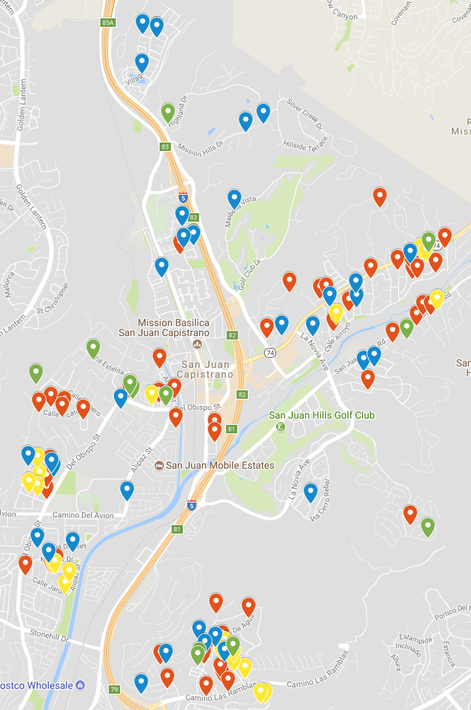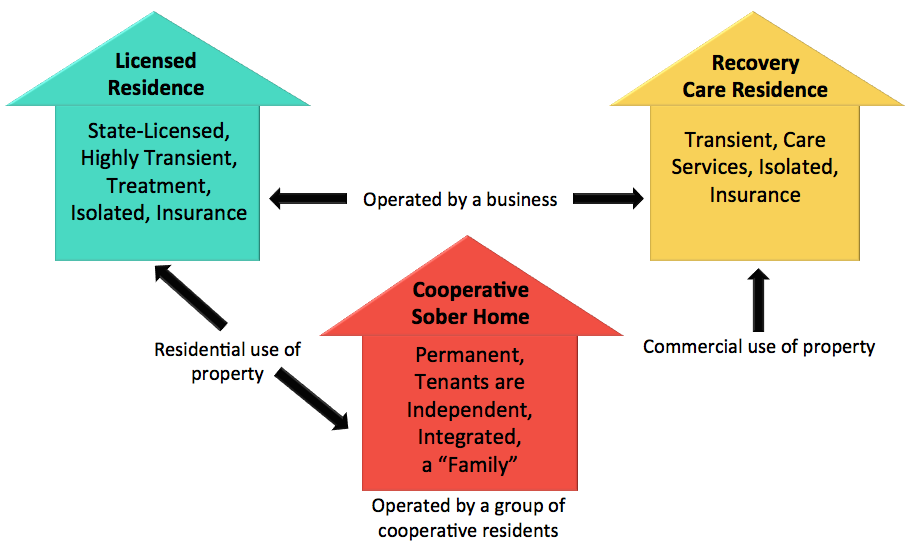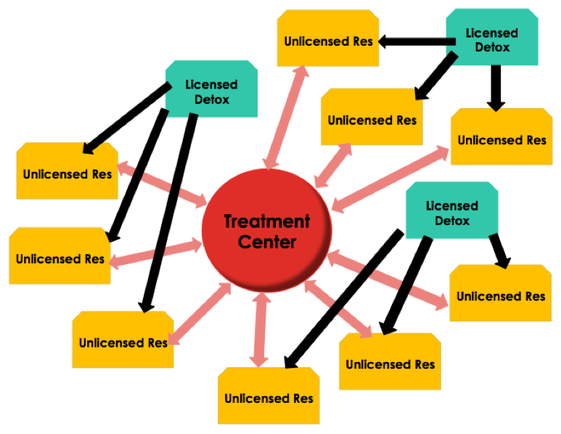Residential Recovery: How the Cities Experience It
California refuses to track unlicensed Residential Recovery, pretending that vulnerable addicts living in such homes are living independently, while industry contributes to this charade by referring to the properties where addicts are active in recovery as "Sober Living Homes." In addition, while the State has a mandate from the Legislature to ensure that sufficient Residential Recovery is provided, the Legislature has never codified:
• whether all of the licenses could be granted to one county,
• whether they should be based on local need, or
• whether California intended to provide recovery services to addicts coming to California for treatment.
State licensing is thus like a spigot that has been turned on with no intention other than to continue to pour out licenses. In any year, Orange County had 42-49% of the state's licensed 6-and-under Residential Recovery houses, with only 8% of the population.
• whether all of the licenses could be granted to one county,
• whether they should be based on local need, or
• whether California intended to provide recovery services to addicts coming to California for treatment.
State licensing is thus like a spigot that has been turned on with no intention other than to continue to pour out licenses. In any year, Orange County had 42-49% of the state's licensed 6-and-under Residential Recovery houses, with only 8% of the population.
From a city's perspective, there are three types of housing that may be operating within its jurisdiction: Licensed Residences (mostly Detoxes), unlicensed Recovery Residences, and Independent, Cooperative Sober Homes.
Licensed Residence - In California, this is a house where “social model,” “non-medical,” “treatment” services are offered, most often licensed for Detox, but occasionally licensed for more mental health recovery services like talk therapy. “Treatment” services can include pill distribution, counseling, and regular monitoring of occupants. Any house providing “Treatment" is REQUIRED BY LAW TO BE LICENSED in California. California law additionally allows “Incidental Medical Services” to be offered in houses offering “social model” treatment. Occupants typically stay in these houses for 6 to 30 days with reimbursement from private health insurance providers. While clearly a transient, commercial use of a residential property, in which the operator is in control of the house, these houses are exempted from municipal interference by California State Health Code declaring them a “residential use” of property.
Recovery Residence - While these houses are technically not allowed to provide treatment, they still provide many other commercial services--some unnecessary to the recovery process--including grocery provision, meal preparation, transportation to and from treatment and activities, pickup and delivery of medication, scheduling events in which the residents participate each week, and a paid staff member on the premises to supervise occupants. The residence is operated as an institution. Transient occupants are not encouraged to get a job or integrate with the community because they are not considered far enough along in their recovery to engage in these activities. Occupants contract with the TC for housing and do not see the property or neighborhood in advance. Fitness centers, public parks and local AA meetings are exploited as inexpensive, group activities. This is clearly a commercial use of the property, in which housing and services are provided in exchange for compensation.
Independent, Cooperative Sober Home - The key difference between Independent, Cooperative Sober Homes and the previous two types of residences is that residents in Independent, Cooperative Sober Homes make their own choices. Tenants live independently and handle their own scheduling and meals. They have the right to interview or screen incoming tenants and participate in the hiring of service providers, including gardeners and house cleaners. Each resident contributes individually to rent. While residents in these homes are often not actively undergoing treatment, they enter an agreement with their fellow tenants to maintain an alcohol and substance-free living environment, and many choose to attend AA or NA meetings of their own accord. This is considered a true residential use of a residential property by law.
Recovery Residence - While these houses are technically not allowed to provide treatment, they still provide many other commercial services--some unnecessary to the recovery process--including grocery provision, meal preparation, transportation to and from treatment and activities, pickup and delivery of medication, scheduling events in which the residents participate each week, and a paid staff member on the premises to supervise occupants. The residence is operated as an institution. Transient occupants are not encouraged to get a job or integrate with the community because they are not considered far enough along in their recovery to engage in these activities. Occupants contract with the TC for housing and do not see the property or neighborhood in advance. Fitness centers, public parks and local AA meetings are exploited as inexpensive, group activities. This is clearly a commercial use of the property, in which housing and services are provided in exchange for compensation.
Independent, Cooperative Sober Home - The key difference between Independent, Cooperative Sober Homes and the previous two types of residences is that residents in Independent, Cooperative Sober Homes make their own choices. Tenants live independently and handle their own scheduling and meals. They have the right to interview or screen incoming tenants and participate in the hiring of service providers, including gardeners and house cleaners. Each resident contributes individually to rent. While residents in these homes are often not actively undergoing treatment, they enter an agreement with their fellow tenants to maintain an alcohol and substance-free living environment, and many choose to attend AA or NA meetings of their own accord. This is considered a true residential use of a residential property by law.
The lifeblood of an Addiction Treatment Center business is the pipeline of recovery: Licensed Detox-->Recovery Residence-->Independent, Cooperative Sober Home. Treatment Centers want to "own" their own licensed Detox or Detoxes, and then move clients into Recovery Residences. If treatment is restricted solely to the Treatment Center, Recovery Residences can claim to be Independent, Cooperative Sober Homes and a residential use of property and fly beneath the radar of regulation. In Orange County, a single Detox will average approximately 2 weeks of stay for 6 clients. If all of the clients were to remain with the same business through multiple phases of treatment, the Treatment Center would need to provide for up to between 8 and 10 weeks of housing on a subsequent property, sticking to 6 per property if operating legally, treating a total of 24 to 42 clients between 4 and 7 unlicensed properties. Thus, each licensed Detox spawns demand for up to 7 unlicensed homes. In 2018, San Juan Capistrano, for instance, had 11 licensed Detoxes (+ 3 licensed treatment residences), which suggested demand for Recovery properties was 44 to 77 houses. This statistic ignores additional unlicensed houses in which Treatment Centers do not have a financial interest (separate tenancy contract) or for which they operate a licensed Detox in another city, and additional houses committed to Independent, Cooperative Sober Homes to which Recovery Resident tenants may move when they are done with recovery.

The map to the left shows known and potential recovery residences in San Juan Capistrano in 2017.
Key
Green flags mark state-licensed recovery residences and detoxes.
Red flags mark unlicensed recovery care residences.
Yellow flags mark suspected unlicensed residences.
Blue flags mark blocks where Sheriff's Blotter events associated with an unknown recovery residence occurred.
Key
Green flags mark state-licensed recovery residences and detoxes.
Red flags mark unlicensed recovery care residences.
Yellow flags mark suspected unlicensed residences.
Blue flags mark blocks where Sheriff's Blotter events associated with an unknown recovery residence occurred.
How Specific Cities are Dealing with Recovery Residences
|
Costa Mesa
Costa Mesa calls unlicensed Recovery Residences "Sober Living Homes" in their regulations. The city's regulations aim to benefit the disabled, requiring 650 feet of separation between houses to reduce the risk of over-concentration, requiring operators have background checks and that occupants have no criminal backgrounds for violence. Dana Point Dana Point sues individual Recovery Residences, charging they are operating without a license. |
Laguna Niguel
In 2018, Laguna Niguel adopted ordinances almost identical to those in Costa Mesa, requiring that Recovery Residences maintain 1000 feet of separation. San Clemente San Clemente has set aside zones for transient housing, barring such uses of property in certain single-family, residential zones. San Juan Capistrano San Juan Capistrano has eliminated short-term rentals entirely. |
Prescott, Arizona: A Model City?
In September of 2013, Prescott, Arizona passed an ordinance that required a 1,200 foot buffer between Recovery Residences they dubbed "structured sober homes." The ordinance also included some parking regulations and a limit to seven unrelated people living in each residence. In March of 2015, the city changed the buffer to 800 feet. In August of the same year, the Department of Housing and Urban Development concluded an investigation on the ordinance, preliminarily suggesting that it did not violate federal law. Eventually, in February of 2017, the Department of Justice released a statement saying that the 800-foot buffer did not violate the Fair Housing Act and had the potential to benefit recovering addicts by mitigating over-concentration of recovery residences.

